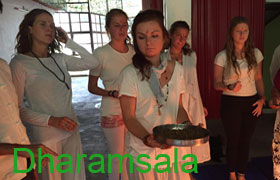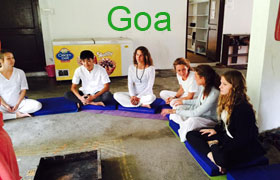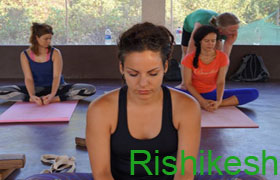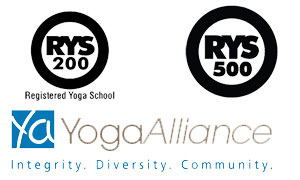Setu Bandha Asana
Procedure
1. Lie down straight on your back on the floor. Keep both of your hands in normal position.
2. Now fold both of your legs at your knees and place your ankles near your butts. Both of your knees should be facing the sky.
3. Raise your waist upwards to the extent possible. You can take the support of your hands if you need.
4. Finally try to keep your legs straight and keep your feet on the floor firmly. This is the final posture of this asana.
5. Pause in this position for a while and get back to normal position gradually.
Benefits
1. Highly beneficial for people suffering with back ache, irregular menstrual periods, blennenteria and uterus problems in women and Spermatorrhoea in men. It refreshes the mind and body.
Precautions
You should not practice this if you suffer with hernia.
Matsya Asana – A
Matsya asana is based on padmasana. It is important for those who cannot practice padmasana.
Procedure
1. Keep your hands near to your body and keep your body straight.
2. In the next stage, raise your hands backwards and place your palms under your shoulders. With the help of your hands raise your spine into convex shape and place your center of your head on the ground.
3. Finally bring your hands forward and place your elbows on the ground and palms on your stomach.
4. Pause in this posture for a while and return to normal state following the same steps in the reverse order.
Benefits
1. Helpful for neck pain, back ache, hip pain, throat and Laryngo.
Precautions
You should not practice this asana if you have injury in head or if you suffer with hernia.
The yoga teacher training in Dharmasala will train you with all these asanas to the expert level.
Pada Angustana Nasa Sparsha Asana
This asana should be practiced with single leg first and then with both the hands.
Procedure
1. Lie down on your back straight on the floor. Now bend your left leg at your knee and hold your feet with both of your hands. Then slowly raise your head and make the toe of your left feet touch your nose. Gradually get back to the normal state following the reverse order of the process. Then repeat the procedure with the other leg.
2. Now fold both of your legs at the knees and hold the toes of both the legs with your hands and raise them over your head and make them touch your nose. Pause in this posture for a while and revert to the normal state.
Benefits
1. It is helpful for people whose navel is deflected.
2. This asana is highly beneficial for women
3. It works well on the lower abdomen.
4. It is helpful to cure knee pain.
Precautions
This asana should not be practiced if you have undergone any surgery for knees or if you suffer with back ache.
Nauka Asana
The final posture of this asana looks similar to a boat. The meaning of ‘nauka’ is boat. Hence it is called nauka asana.
Procedure
1. Place your hands straight on the floor and also keep your body straight.
2. In the second stage, inhale air into your chest and raise both of your legs gradually to an angle of 450 from the ground. Now slowly raise your head also to the same angle. Keep your hands parallel to the ground. Pause in this posture for a while and revert to the original state by first dropping the head slowly followed by your legs.
Benefits
1. Helpful for all the issues related to abdomen.
2. It is helpful in improving the functionality of the stomach and liver.
3. Highly beneficial for diabetes and lack of appetite.
Precautions
This asana should not be practiced if you suffer with high blood pressure, back ache or any pain in stomach.
Sarvanga Asana
‘Sarva’ means ‘all’ and ‘ang’ means parts. This asana influences every part of the body. Thus it is called sarvanga asana.
Procedure
1. Start by keeping your hands and legs straight and lie down on your back on the floor.
2. Inhale air into your chest and slowly raise your legs to 300, 600 and 900 from the floor. Pause in this position for a while.
3. Now move your legs by lifting your waist up and take them backwards.
4. Push your back straight with the help of your palms and move your chin into your chest. Meanwhile keep both of your legs straight. Neck and shoulders stay on the ground.
5. Pause in this posture for a while and move your legs back and place both of your hands on the ground. Then slowly drop your legs to 900, 600, 300 angle and then on to the floor.
Benefits
1. Highly beneficial for Epilepsy, semen defects, arthritis, blood circulation, neck, brain, kidney and all sense organs.
2. Improves the functionality of thyroid and makes it healthy.
Precautions
1. This asana should not be practiced if you suffer with blood pressure.
2. Sarva anga asana should not be practiced if you suffer with neck pain, hip pain, or any disease related to nose, eyes or ears.
Matsya Asana – B
It is a very good practice to do matsya asana after sarva anga asana. It can provide multiple benefits.
Procedure
1. First of all stretch both of your legs straight and sit in danda asana. Then place your hands near your thighs and Keep your body straight.
2. Fold each leg and sit in padmasana.
3. Take the support of your elbows to slowly lie on the support of your back.
4. After you lie down properly on your back, raise both of hands backwards and place them behind your shoulders. With the support of your hands, slowly raise your neck and chest upwards. The middle part of your head, elbows and both of your knees should be on the floor.
5. In the final stage hold the toes of both your legs with your hands and pause in this posture for a while. Now get back to the normal state by following the same process in the reverse order.
Benefits
1. Makes the thyroid, cervical region, neck healthier. It is helpful if you are affected with any pain in these areas.
2. Improves blood circulation in to face and brain. Thus it improves the memory.
3. Makes the spinal cord flexible. It improves the functionality of respiratory system.
4. It highly beneficial for asthama.
5. It is can be practiced when you are affected with fever and get relieved too.
Precautions
1. It should not be practiced if you have any trouble in your eyes or ears.
2. It should not be practiced if your cerebral vein is weak.
3. It should not be practiced if any pain persists in the neck.
The yoga teacher training in Rishikesh provides the best ever training in the worl for all these asanas.




